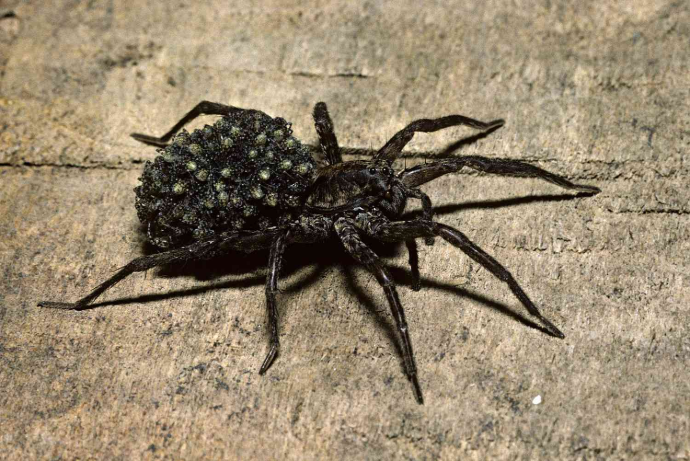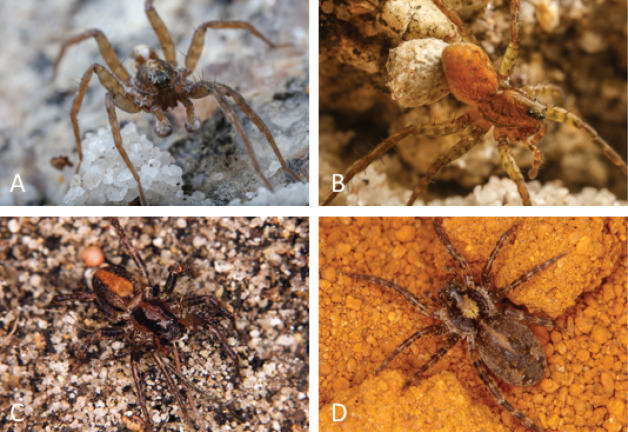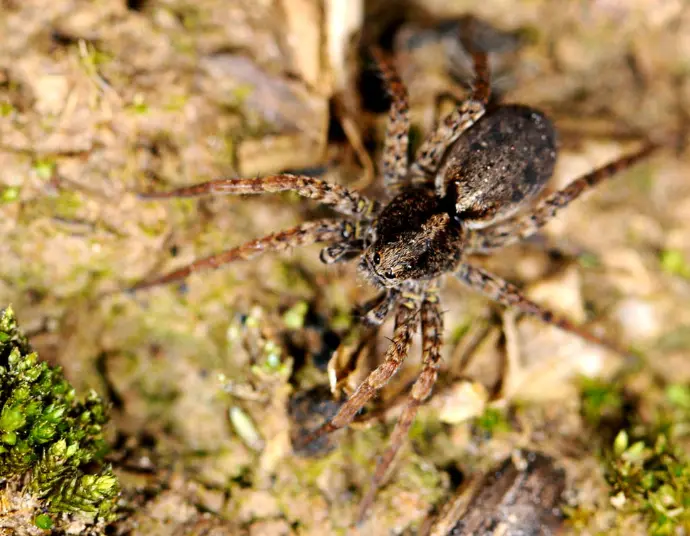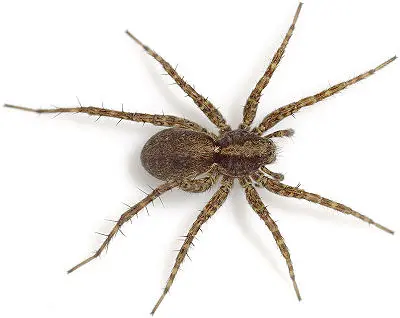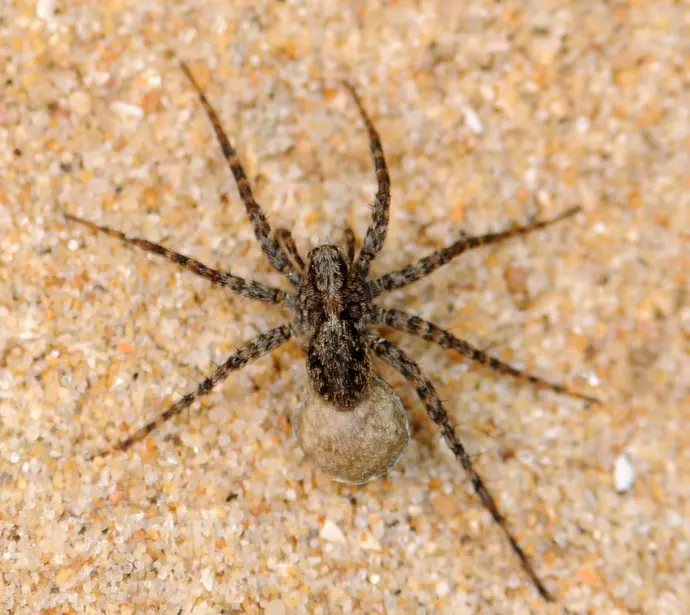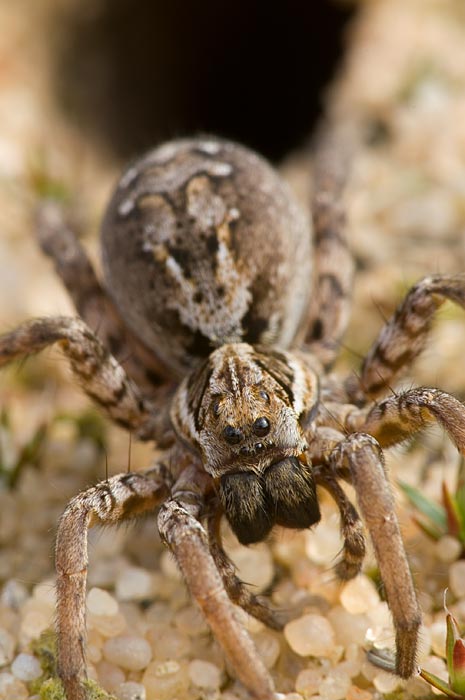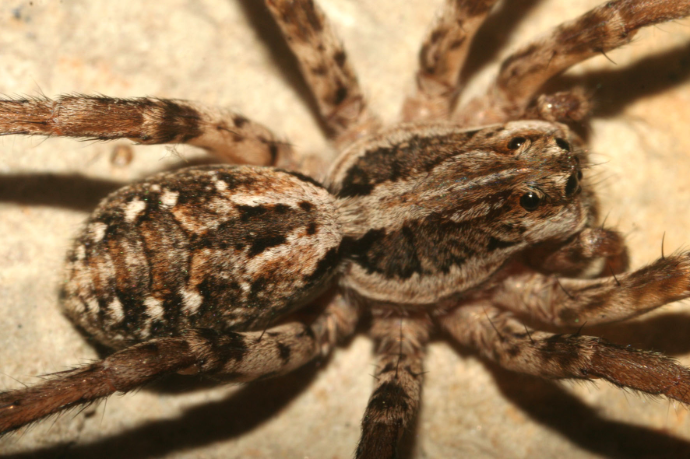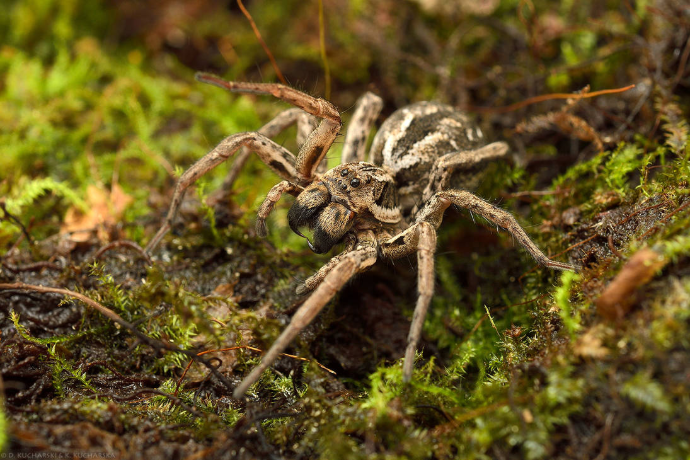The Wolf Spiders of the Word  By Volker W. Framenau
By Volker W. Framenau
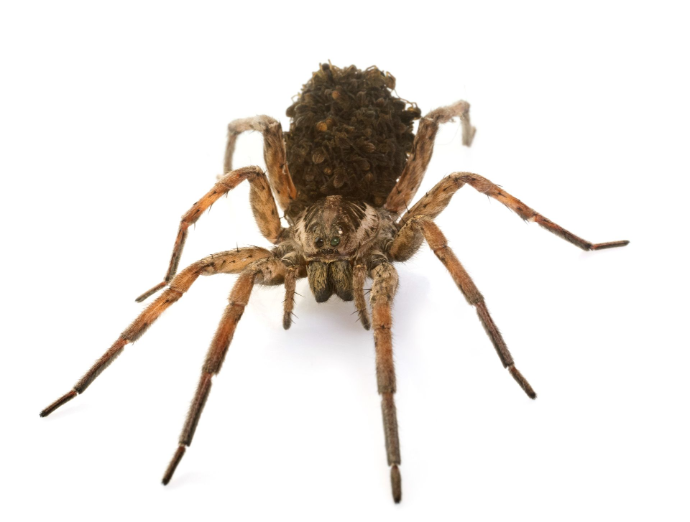
The family Lycosidae, commonly known as wolf spiders, encompasses a vast number of species distributed worldwide. As of December 29, 2013, there were numerous described species across various genera.
Discover more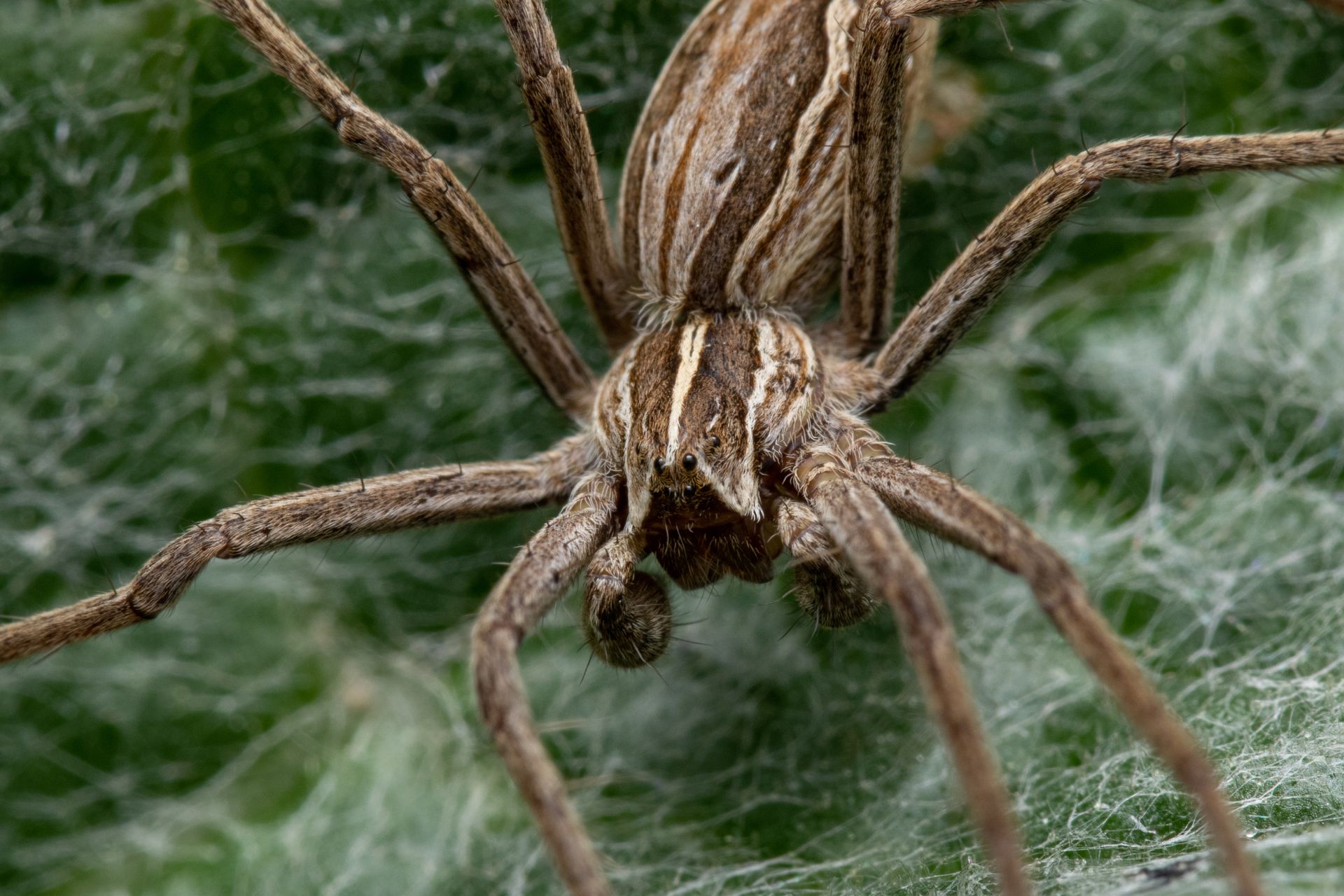
In North America, north of Mexico, there are approximately 240 species in 21 genera.
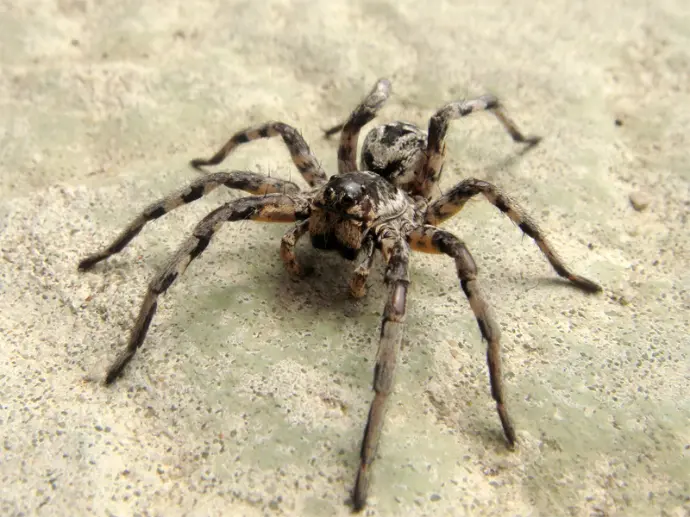
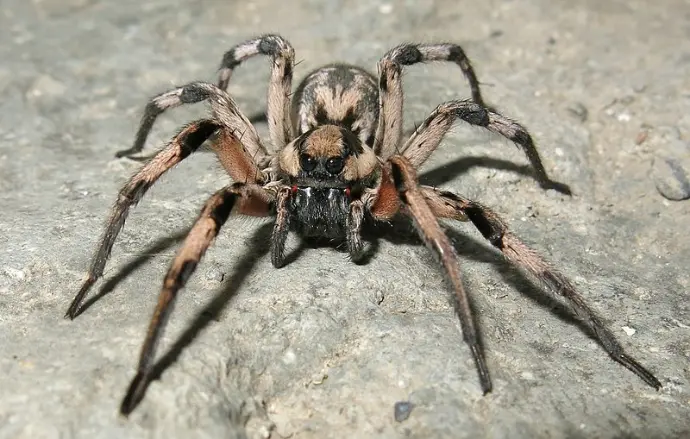
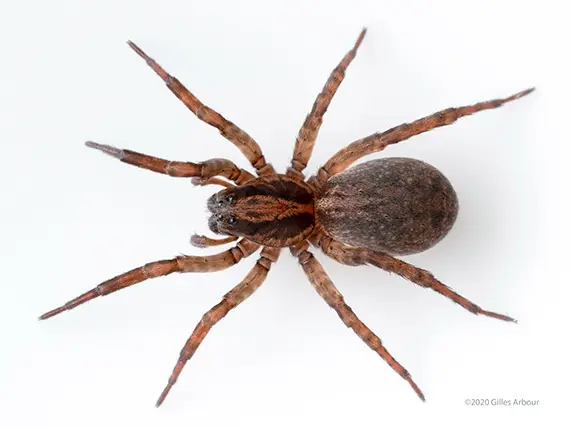
In the Western Mediterranean, particularly in the Maghreb region (Tunisia, Algeria, and Morocco), 24 species have been described or recorded.
Wolf spiders, belonging to the family Lycosidae, are globally distributed and known for their hunting prowess. Below is a selection of notable species, along with their scientific names, common English names, and local names where available :
Venatrix furcillata
- Common English Name: Little wolf spider
- Local Name: Little wolf spider (Australia)
- Distribution: Eastern Australia
- Notes: Found in suburban gardens and lawns; known to migrate to communal webs.
Pardosa amentata
- Common English Name: Thin-legged wolf spider
- Local Name: Dünnbeinige Wolfsspinne (Germany)
- Distribution: Europe
- Notes: Common in moist habitats like riverbanks and meadows.
Alopecosa fabrilis
- Common English Name: Garden wolf spider
- Local Name: Garten-Wolfspinne (Germany)
- Distribution: Europe
- Notes: Often found in gardens and open woodlands.
Pirata piraticus
- Common English Name: Pirate wolf spider
- Local Name: Piratenspinne (Germany)
- Distribution: Europe
- Notes: Inhabits wetlands and is known for its swimming ability.
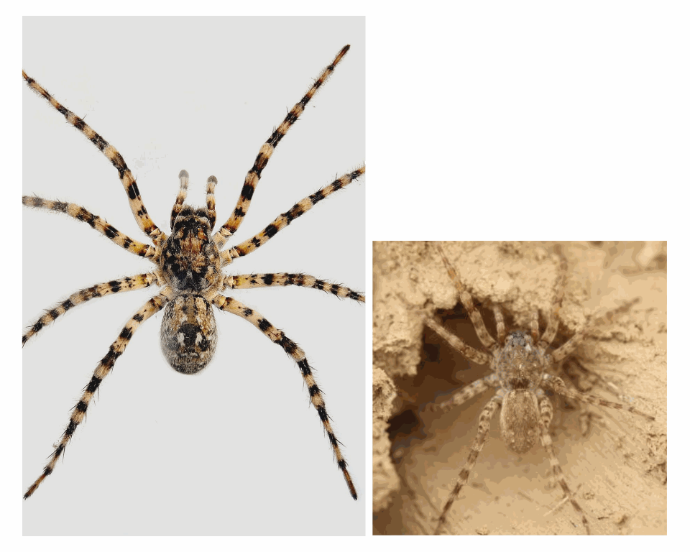
Arctosa cinerea
- Common English Name: Beach wolf spider
- Local Name: Strandwolfspinne (Germany)
- Distribution: Europe
- Notes: Found in sandy coastal areas; camouflages well with its environment.

Lycosa erythrognatha
- Common English Name: Red fang wolf spider
- Local Name: Aranha-de-ferradura (Brazil)
- Distribution: South America
- Notes: Recognizable by its reddish chelicerae; found in various habitats.

Lycosa singoriensis
- Common English Name: Russian wolf spider
- Local Name: Russische Wolfsspinne (Germany)
- Distribution: Eastern Europe, Central Asia
- Notes: One of the largest wolf spider species; inhabits steppes and semi-deserts.
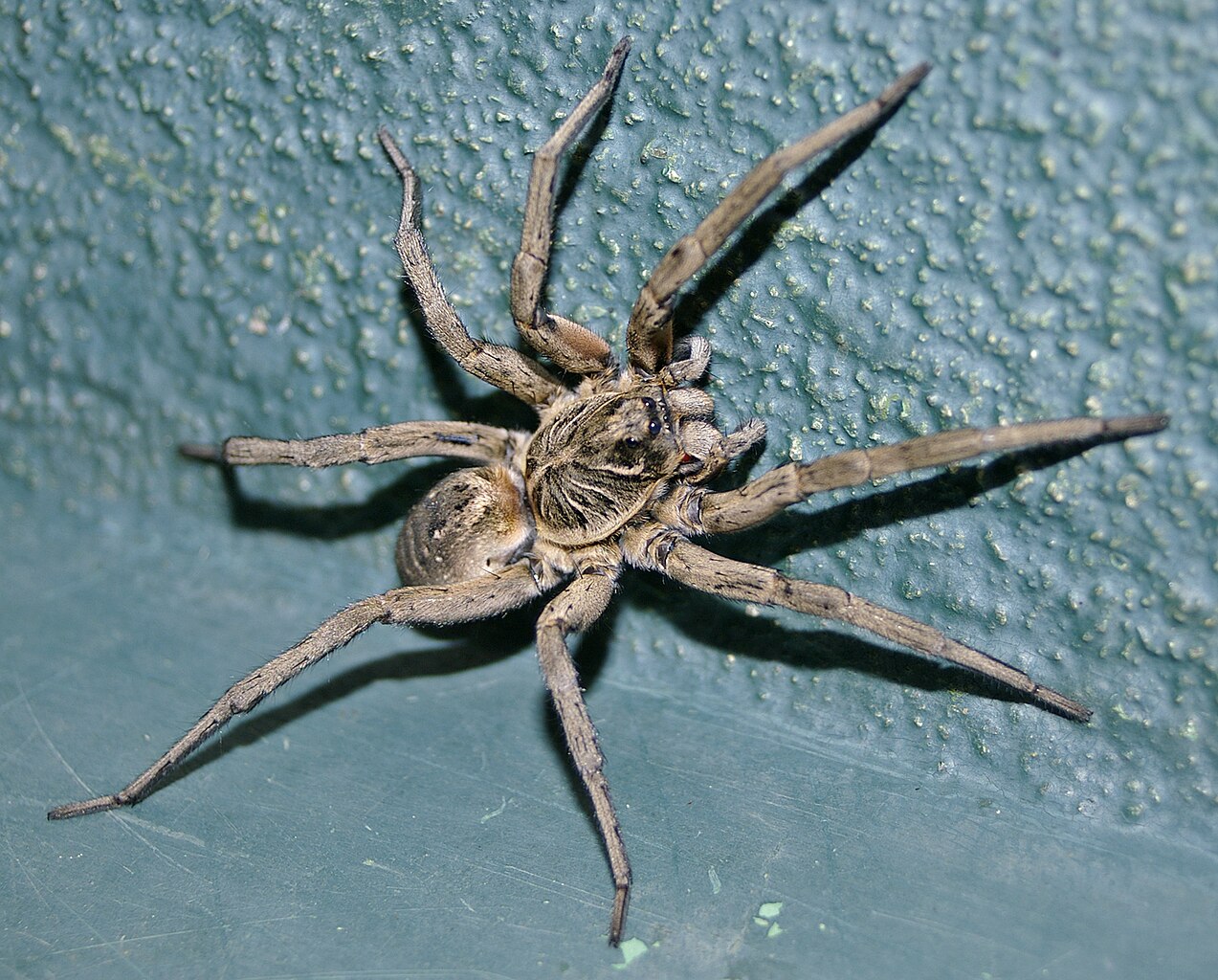
Lycosa leuckarti
- Common English Name: Australian wolf spider
- Local Name: Australian wolf spider (Australia)
- Distribution: Australia
- Notes: Common in open forests and grasslands; known for carrying its egg sac attached to spinnerets.
Lycosa singoriensis :
A Distinctive Member of the Lycosaidae Family
Lycosa singoriensis is a notable wolf spider species within the Lycosaidae family, widely distributed across parts of Europe and Asia. Known for its robust build and characteristic hunting behavior, this species contributes significantly to the ecological balance by controlling insect populations.
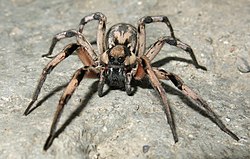
Physical Characteristics
Lycosa singoriensis typically exhibits a body length ranging from 15 to 25 mm, with females generally larger than males. Their coloration is usually brownish with distinct darker markings, which provide excellent camouflage in their natural habitats such as grasslands, forests, and scrublands.
Behavior and Habitat
Unlike web-building spiders, Lycosa singoriensis is a ground-dwelling hunter, relying on speed and agility to capture prey. It is primarily nocturnal, emerging at dusk to hunt insects and other small arthropods. The species is also known for its maternal care; females guard their egg sacs and newly hatched spiderlings until they are capable of independent survival.
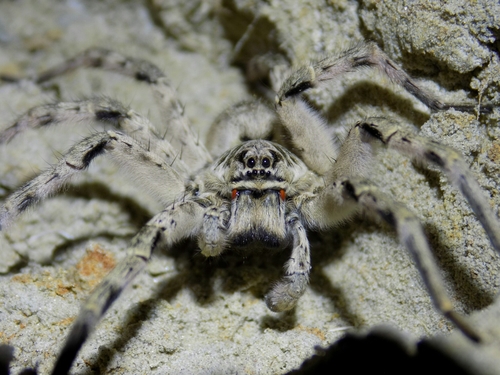
Importance in Research and Ecology
Due to its widespread distribution and role as a natural pest controller, Lycosa singoriensis is often studied in ecological and behavioral research. Understanding its life cycle and habitat preferences aids in biodiversity conservation and agricultural pest management.

Tarantulas : Fascinating Facts About These Giant Spiders
Tarantulas are some of the most captivating and misunderstood creatures in the spider family. Known for their intimidating size and unique behaviors, these arachnids spark curiosity in many. This article dives deep into several fascinating aspects of tarantulas, from their size comparison with other spiders, their diet, lifespan, and habitat, to their intriguing eyes. Let's explore the world of tarantulas !
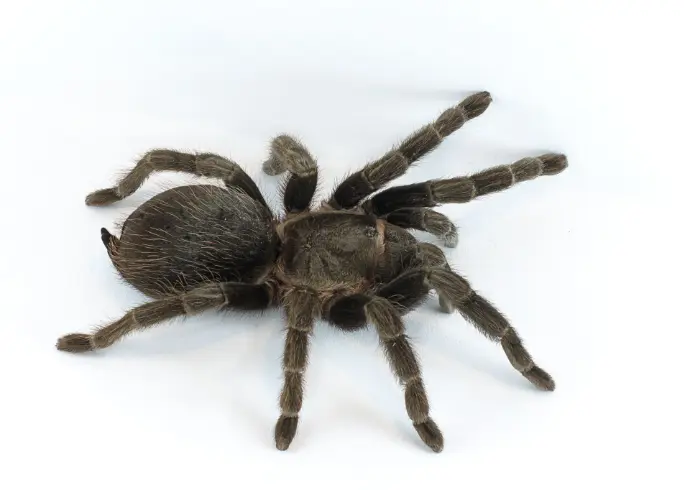

Tarantula vs. Wolf Spider :
Size Comparison / lycosa tarantula size
When it comes to size, tarantulas are often considered the giants of the arachnid world. However, wolf spiders can also grow quite large. Tarantulas can have leg spans ranging from 4 to 12 inches, depending on the species, with the Goliath Birdeater being the largest at around 12 inches across. In comparison, wolf spiders are smaller, typically measuring 1 to 4 inches, with their legs extended. While the wolf spider is known for its agility and speed, the tarantula stands out because of its sheer size and powerful defensive behaviors.
🕷️ Lycosa tarantula Size : Understanding the Dimensions of the European Tarantula
The Lycosa tarantula, commonly known as the European tarantula, is a fascinating spider species native to the Mediterranean region. Known for its distinctive hunting style and impressive size, this spider often sparks curiosity about its physical dimensions. In this article, we explore the typical size of Lycosa tarantula, factors influencing its growth, and how it compares to other wolf spiders.

What Is the Average Size of Lycosa tarantula ?
- The adult Lycosa tarantula exhibits considerable size, making it one of the larger wolf spider species in Europe.
- Body Length: Adults generally range from 20 to 30 millimeters (2 to 3 centimeters) in body length (excluding legs). Females are usually larger than males.
- Leg Span: The leg span can reach up to 70 to 80 millimeters (7 to 8 centimeters), giving the spider an imposing appearance despite its relatively moderate body size.
Factors Affecting the Size of Lycosa tarantula
Several factors can influence the overall size of Lycosa tarantula specimens :
1. Sexual Dimorphism : Female Lycosa tarantula spiders tend to be larger and bulkier, especially in the abdomen area, while males are slimmer with longer legs adapted for mating behaviors.
2. Age and Maturity : Size increases with age, as spiders grow through multiple molts before reaching full maturity. Younger spiders are noticeably smaller and less robust.
3. Environmental Conditions : Availability of food, habitat quality, and climate can all impact growth rates and ultimate size. Spiders in nutrient-rich environments tend to grow larger.
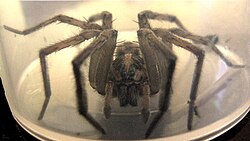
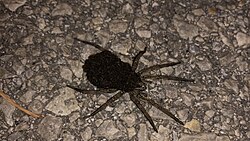
How Does Lycosa tarantula Compare to Other Wolf Spiders ?
While Lycosa tarantula is among the largest wolf spiders in Europe, it is smaller compared to some tropical wolf spider species and true tarantulas (family Theraphosidae), which can exceed 100 millimeters in body length.
| Species | Average Body Length | Typical Habitat | Notes |
|---|---|---|---|
| Lycosa tarantula | 20-30 mm | Mediterranean Europe | Largest European wolf spider |
| Lycosa tarentula (North Africa) | 30-40 mm | North Africa | Slightly larger related species |
| Grammostola rosea (Chilean tarantula) | 80-100 mm | South America | True tarantula, much larger |
Why Does Size Matter ?
Understanding the size of Lycosa tarantula is important for :
- Identification : Size helps distinguish this species from other local spiders.
- Ecological Role : Larger spiders are efficient hunters, controlling insect populations.
- Pet Keeping : Enthusiasts interested in keeping wolf spiders or tarantulas as pets need to know size for proper enclosure sizing.
The Lycosa tarantula is an impressive species whose size varies between 20 and 30 mm in body length with a leg span reaching up to 8 cm. Females are generally larger than males, and environmental factors influence overall growth. Compared to other wolf spiders and true tarantulas, Lycosa tarantula holds a unique position as the largest wolf spider native to Europe.
Adults typically reach 20-30 mm in body length with leg spans up to 80 mm.
No, Lycosa tarantula is a wolf spider species and much smaller than true tarantulas (family Theraphosidae).
Yes, females are generally larger and bulkier than males.
What Do Tarantulas Eat ?
Tarantulas are carnivorous and feed primarily on insects. Their diet includes crickets, grasshoppers, cockroaches, and beetles, but they are also capable of eating larger prey such as small rodents, birds, and lizards. Tarantulas hunt by using their venomous fangs to immobilize and paralyze their prey, before using their chelicerae (mouthparts) to tear it apart and consume it. While they can go for extended periods without food, tarantulas generally need to eat once every few weeks, depending on their age and species.
How Long Do Tarantulas Live ?
The lifespan of a tarantula depends on its species, but tarantulas are known for their longevity. Female tarantulas typically live much longer than males. Female tarantulas can live anywhere from 10 to 30 years, with some species, like the Mexican Red Knee, living up to 30 years. Males, on the other hand, usually live only 3 to 7 years, as their primary goal is to reproduce. The shorter lifespan of males is linked to the fact that they die soon after mating.
Where Do Tarantulas Live ?
Tarantulas are found in a wide range of habitats around the world, primarily in tropical and subtropical regions. They are most commonly associated with rainforests but can also be found in deserts, grasslands, and even some temperate climates. Tarantulas burrow underground or hide in crevices for shelter, and they often create elaborate webs to trap prey. Some species, like the African Horned Tarantula, prefer to live in the trees, using their webs for both shelter and hunting grounds.
Tarantula Eyes: What Do They See ?
A unique feature of tarantulas is their set of eight eyes, which is relatively small compared to their body size. While they don't rely heavily on vision, they use their eyes to detect changes in light and movement. Their primary sense for hunting and navigation is their sensitive hairs and vibrations, which help them detect prey and threats. Tarantulas have poor eyesight, typically only able to detect shadows or movement from a distance, but their keen sense of touch more than compensates for this limitation.

Tarantulas, while formidable predators themselves, have a number of natural enemies. "Name three predators of the tarantula" – these include birds, such as hawks and owls, small mammals like mongooses, and reptiles, particularly certain species of snakes. These predators often target tarantulas for their protein-rich bodies, despite the tarantula’s ability to defend itself with venom and sharp fangs.
Lycosa singoriensis
Lycosa singoriensis, commonly known as the desert wolf spider, is a remarkable species of wolf spider that inhabits a variety of ecosystems, particularly arid regions and sandy terrains. This species is renowned for its impressive hunting skills, agility, and distinctive appearance. Lycosa singoriensis plays a vital role in controlling insect populations, making it an essential part of its native ecosystem.
Taxonomy and Classification :
- Kingdom: Animalia
- Phylum: Arthropoda
- Class: Arachnida
- Order: Araneae
- Family: Lycosidae
- Genus: Lycosa
- Species: Lycosa singoriensis
Lycosa singoriensis belongs to the Lycosidae family, which is commonly known for its fast-moving, ground-dwelling nature. It shares similarities with other wolf spiders, such as its predatory behavior, and is one of the largest species within its genus.
Habitat and Distribution :
Lycosa singoriensis is primarily found in arid and semi-arid environments, especially in North Africa and parts of the Middle East. It thrives in sandy soils, desert dunes, and shrubland areas. These spiders construct burrows or occupy natural cavities in the ground, where they remain camouflaged and ready to ambush prey. Their excellent adaptation to harsh climates makes them a key species in maintaining the balance of local ecosystems.
Physical Characteristics :
- Size: Females can reach up to 3 cm in body length, with a leg span of approximately 7 cm.
- Coloration: Typically brown or grayish with darker markings that help it blend into its desert surroundings.
- Distinctive Features: Lycosa singoriensis has long, robust legs and a powerful set of mandibles, ideal for capturing and subduing prey. The eyes are arranged in a characteristic pattern, allowing it to have an extensive field of vision.
Behavior and Hunting :
Lycosa singoriensis is a predatory species, relying on speed and stealth to capture its prey. Unlike some spiders that build webs to catch food, Lycosa singoriensis is an active hunter. It hunts by ambushing smaller insects, including beetles, ants, and grasshoppers, which it captures with its powerful chelicerae. These spiders are also known for their agility, swiftly chasing down and subduing prey that attempts to escape.
Lycosa singoriensis is a terrestrial spider, meaning it is adapted for life on the ground, where it roams in search of food and mates. Its hunting techniques include quick bursts of speed, aided by its long, strong legs, which help it move rapidly across the sand.
Reproduction :
Lycosa singoriensis engages in sexual reproduction, with males performing a complex courtship ritual to attract females. After mating, females produce a sac containing numerous eggs, which they guard until the spiderlings hatch. The young spiders stay with the mother for a short period before dispersing to find their own territories.
Ecological Role :
As a carnivorous spider, Lycosa singoriensis plays an essential role in controlling the populations of various insect species. By preying on pests, it helps maintain the balance of the ecosystem and prevents overpopulation of certain species. Additionally, this species serves as prey for other larger predators, contributing to the food web.
Conservation Status :
Currently, Lycosa singoriensis is not considered threatened, but habitat destruction and climate change could pose future risks. As desert environments are increasingly affected by human activity, the species’ natural habitat may be disrupted, which could impact its populations in the long term.
Key Facts :
- Diet: Insects, including beetles, grasshoppers, and ants
- Habitat: Sandy, arid regions; burrows in the ground
- Size: Females up to 3 cm in body length
- Behavior: Active hunter, ambushing prey
- Role: Pest control and food source for larger predators
=> Lycosa singoriensis is a fascinating and important species within the Lycosidae family. Its role as an efficient predator and its unique adaptations to arid environments make it an essential part of its ecosystem. Understanding this spider’s behavior, ecology, and conservation needs helps in promoting the protection of its habitat and ensuring the continued balance of desert ecosystems.


The Role of Lycosidae / Lycosa in Biodiversity and Biotechnology Research
Lycosidae (wolf spiders) are fascinating creatures with a significant role in biodiversity and ecological balance. In recent years, these spiders have attracted attention in biotechnology research for their unique protein production and potential in biomaterials. Learn how their genetic and biochemical properties are advancing biotech research.
- Lycosidae and their ecological role in controlling pests and maintaining biodiversity.
- Biotechnological potential of wolf spider silk and proteins in biomedical applications, such as wound healing and drug delivery systems.
- Innovations in bioengineering using spider silk proteins for synthetic biomaterials.
Exploring the Genetic Makeup of Lycosidae : Insights into Biotechnology
With their remarkable hunting abilities and adaptability, Lycosidae species are increasingly studied for their genetic makeup and how their unique traits could benefit the field of biotechnology. This blog explores how studying the genetic properties of wolf spiders can open new doors in biomaterials, and more.
- Genetic sequencing and insights from Lycosidae DNA used for biotech applications.
- Understanding Lycosidae protein synthesis and how this contributes to the development of biomedical materials.
- Future genetic engineering prospects for improving spider-derived materials in medicine and technology.


Lycosidae Proteins : The Future of Biotech
Lycosidae proteins, particularly those found in spider silk, have shown promising potential in the field of discovery. Their unique properties make them an ideal candidate for new biotech treatments. In this blog, we explore how these proteins are used in creating dr u g delivery systems, biomolecular interactions, and more.
- Spider silk proteins as a d r u g delivery vehicle and their applications in nanotechnology.
- Biotechnological approaches using Lycosidae proteins in the development of targeted therapies for cancer and other diseases.
- The role of Lycosidae proteins in biomolecular interactions and their contribution to bioscience innovation.
From Lycosa Singoriensis to Lycosa Tarantula
The Lycosidae family, commonly known as wolf spiders, captivates arachnologists and nature enthusiasts alike. Among the many intriguing species in this family, the Lycosa singoriensis stands out due to its distinctive behaviors and habitat preferences. This blog explores various members of the Lycosidae family, including detailed insights into Lycosa tarantula, its size variations, and comparisons with related species like Lycosa erythrognatha.
Understanding Lycosidae : The Wolf Spider Family
The Lycosidae family encompasses a diverse group of robust, agile spiders often mistaken for tarantulas due to their size and hunting techniques. Unlike web-spinning spiders, wolf spiders are active hunters, relying on keen eyesight and speed.
Lycosa Singoriensis : A Closer Look
Lycosa singoriensis is a noteworthy species within the Lycosidae family. Found across Eurasia, it is known for its ground-dwelling habits and distinctive hunting patterns. Studying this species helps researchers understand predator-prey dynamics within terrestrial ecosystems.
Lycosa Tarantula Size and Its Relatives
When discussing size, the Lycosa tarantula often draws attention. Known for its impressive stature, the lycosa tarantula size varies depending on habitat and diet but generally ranges among the larger wolf spiders.
Large Wolf Spider Size Comparison
Comparing the large wolf spider size across species offers valuable data for taxonomists and ecologists. For instance, the size of lycosa tarantula often exceeds that of lycosa erythrognatha, highlighting the diversity within the Lycosidae family.
Wolf Spider Hand Comparison
An interesting way to appreciate the size of these spiders is through wolf spider hand comparison photos, which illustrate just how formidable these creatures appear in relation to human hands—helpful for education and awareness.
Three Predators of the Tarantula
Despite their size and hunting prowess, tarantulas face natural predators. Three main predators of the tarantula include certain wasp species, birds, and small mammals. Understanding these predator relationships is essential for conservation biology and ecosystem management.
Why Study Lycosidae?
Research into the Lycosidae family enhances our knowledge of arthropod ecology and contributes to broader biological and environmental sciences. Genetic and molecular studies, supported by advanced biotechnology products from companies like Gentaur, enable deeper insight into spider physiology and behavior.
The Lycosidae family, especially species like Lycosa singoriensis and Lycosa tarantula, remains a rich subject for scientific study and public fascination. Size comparisons, predator interactions, and behavioral studies enrich our understanding of these remarkable wolf spiders.

